Are your outbound shipping costs eating your 3PL’s profits? Today, we will cover five critical factors affecting your shipping costs and provide actionable tips to help you reduce them. We’ll give insights on everything from delivery speed to special handling fees to ensure you make operational decisions that save time and money.
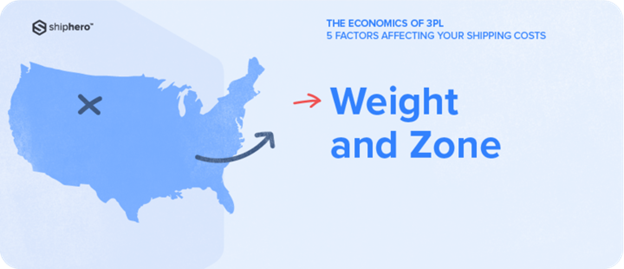
Factor 1 | Weight and Zone
For products shipped domestically within the US, two key factors come into play: the destination zone and the package’s weight.
Zone
Carriers have established nine zones across the US, with the origin address as Zone 1. Your shipping fees increase as your package moves further from its origin. Here are the current zones with their mileage differences from the source.
- Zone 1: 1-50 miles
- Zone 2: 51-150 miles
- Zone 3: 151-300 miles
- Zone 4: 301-600 miles
- Zone 5: 601-1000 miles
- Zone 6: 1001-1400 miles
- Zone 7: 1401-1800 miles
- Zone 8: 1801 miles or greater
- Zone 9: US territories & APO or FPO addresses
Weight
When it comes to shipping packages, weight matters, it’s a simple concept: the heavier the package, the more you’ll have to pay to get it where it needs to go. But it’s not just about weight; the package’s dimensions also play a significant role.
It’s a tricky balance – you want your package to be the right size to hold your products but not so large that it triggers DIM weight surcharges. Investing in a packaging design strategy is worth the time to determine the optimal package size and weight to avoid unnecessary expenses. It’s a small step that can significantly impact your bottom line.

Shipping Calculators by Carrier:
- USPS: Shipping Calculator
- Canada Post: Shipping Calculator
- FedEx: Shipping Calculator
- UPS: Shipping Calculator
International
If you’re not taking advantage of duty relief programs for international shipping, you’re leaving money on the table. The numbers don’t lie – Section 321 alone can save you up to 20% on duty fees, and that’s a significant amount. So, what exactly is Section 321 all about?
Section 321 of the Trade Facilitation and Trade Enforcement Act has revolutionized the eCommerce shipping costs for shippers from Canada or Mexico sending goods into the U.S. to individual customers. With tax and duty exemptions, faster clearance, and reduced paperwork, shippers have remarkable advantages at their fingertips.
Section 321’s duty-free entry for goods valued at $800 USD per person per day is a smart way for businesses to grow, as it offers savings for brands looking to get their items to American consumers. While certain products are restricted, these regulations should not deter businesses from enjoying the benefits Section 321 can bring.
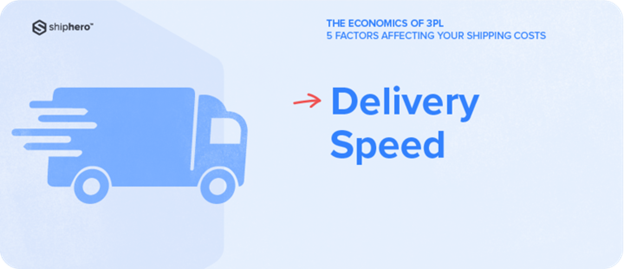
Factor 2 | Delivery Speed
The persistent and aggressive growth in eCommerce demands a seamless process to satisfy customers’ needs, and delivery speed is an essential aspect of any business that hopes to keep up with customer demands in today’s marketplace.
Margin integrity is crucial if you want to stay profitable. At ShipHero, we understand that maintaining a delicate balance between cost and delivery speed is essential for our margins to remain healthy. It hasn’t been an easy process, and we’ve made our fair share of mistakes.
Nevertheless, we’ve learned that customers expect two-day delivery from Amazon but are generally willing to wait three to four days for other businesses. However, specific expectations, such as real-time tracking, still need to be met.
90% of customers want immediate updates and real-time order visibility. Adopting technological solutions can improve delivery experiences and lower consumer inquiries.
32% of global shoppers will abandon their carts if an estimated shipping time is too long. Rising standards are forcing 3PLs and carriers to reevaluate traditional distribution models.
Fulfillment Trends
Get ahead of the trend by utilizing micro-fulfillment centers (MCFs) to cut delivery times. MCFs are strategically placed in urban areas and stocked with popular products, making it easy for customers to pick up their online orders. This gives shippers the flexibility to meet rising consumer expectations promptly.
Although setting up these local centers can be challenging and pricey, it pays off in the long run by reducing shipping costs and providing an efficient and cost-effective service. Leading 3PL companies are already reaping the benefits of this strategy and improving their overall performance.
Last Mile Delivery
Last-mile delivery accounts for 53% of the total shipping cost, and 3PLs simply can’t afford to miss the mark here. The final stage of the delivery process is where customer satisfaction and profitability are either made or broken. Unfortunately, too many managers responsible for supply chain and digital functions face significant challenges in this crucial area.
But fear not; there are solutions. By partnering with the right players, businesses can meet and exceed their customers’ expectations while boosting their bottom line. That’s why we offer Veho’s efficient and cost-effective last-mile delivery solutions.
By prioritizing necessary orders and reducing failed deliveries, Veho can make money while delivering the high level of service customers deserve while saving your 3PL money on last-mile delivery.
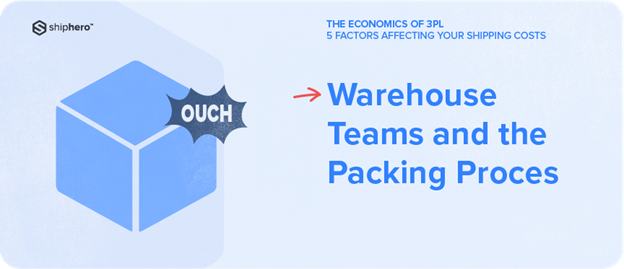
Factor 3 | Warehouse Teams and the Packing Process
When it comes to the efficiency of a warehouse, it’s essential to have a well-oiled team handling the packing process. After all, warehouse teams can make or break the whole operation. Here are some questions to ask yourself regarding your teams.
Are you investing in training your team?
Training is crucial for a proficient team, minimizing staff turnover, and boosting profits. It should cover SOPs, equipment handling, inventory management, customer order systems, and obtaining certification for specific tasks.
How efficient is your packing station?
Regularly assess your packing station’s efficiency to identify areas for improvement and reduce labor costs. Implement one-touch stations and focus on ergonomic design and workflow to optimize productivity and reduce errors.
Are you optimizing your picking paths?
Optimizing your picking paths might be the key to unlocking higher profit margins for your business. It’s simple – a slower picking process leads to increased picking costs, inevitably leading to higher product prices for your customers.
Are you using automation?
While a 95% to 98% order accuracy rate may seem reasonable, it still allows for a 2% margin of error or potentially even worse outcomes. These errors can result in significant financial losses for your warehouse.
Fortunately, implementing warehouse automation can reduce human error and improve inventory control. This will significantly enhance picking accuracy, bringing it closer to 100% and ultimately saving you money by reducing mistakes and mispicks.
Are you analyzing the correct data?
Measuring data is crucial to improve business operations. Knowing your warehouse’s key performance indicators (KPIs) is essential. Collecting and analyzing the correct data identifies inefficiencies and avoidable expenses. You’ll need to track everything from receiving through shipping to get a complete picture of your operations.
Here are a few KPIs to consider:
- Inventory Days of Supply: The day’s sales of inventory (DSI) is a financial ratio that indicates the average time, in days, that a company takes to turn its inventory, including goods that are a work in progress, into sales.

- Parcel Bill Accuracy: Review your parcel bill charges regularly to avoid overcharging. Request detailed bills from carriers if you spot any errors. This information can be helpful when renewing shipping contracts.
- Receiving Efficiency: This metric determines how well the receiving area performs overall. It is determined by the volume of inventory received/ number of hours worked. So, for example, you may receive 2000 goods per week and only have two employees at 40 hours each. So in this example, it would be 2000/80 = 25 goods per hour being processed.

- Order Picking Accuracy: Accuracy in order picking is vital to ensure that orders are shipped correctly. Mistakes can be costly and time-consuming, so tracking this metric is crucial to keep customers happy and avoid the hassle of correcting errors.

- Warehouse Capacity Utilization: Warehouse capacity means the space available to store things. Businesses need to use the area efficiently and save money on warehouse operations.
To understand your warehouse capacity utilization, you can calculate it in a few easy steps. Ideal utilization is 80%, which is average to maximize your warehouse space. To calculate your warehouse’s usable space:
-
- Measure the total square footage, clearance height, and unusable areas (offices, bathrooms, break rooms).
- Subtract the unusable square footage from the total to get the usable square footage.
- Multiply it by the clearance height to obtain the usable volume in cubic feet.
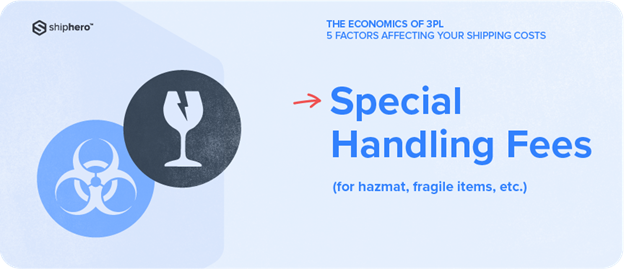
Factor 4 | Special Handling Fees
As a shipper, you’re no stranger to handling fees for hazardous materials and fragile items. But did you know that these fees can have both advantages and disadvantages? Let’s take a closer look at how they can impact your bottom line.
Hazmat
- Revenue Generation: Shippers can generate extra revenue through Special Handling fees, which help cover the expenses of safely transporting fragile or hazardous items. These fees contribute to the overall profitability of the shipping industry.
- Risk Management: To transport hazardous and delicate items safely, shippers should charge special handling fees, conduct inspections, and employ trained personnel. Risk management practices are essential to ensure secure transportation.
- Competitive Advantage: Shipping companies specializing in hazardous and delicate items can become industry leaders by charging extra for their expertise. This draws customers seeking experienced shippers with a deep understanding of complex shipments.
Shipping hazmat and fragile items can be profitable, but shippers must address customer concerns and competition while complying with regulations.
Fragile
When it comes to shipping fragile items, there’s no room for error. After all, damaged items don’t just impact your bottom line – they can also significantly affect your reputation. That’s why taking proactive steps is essential to ensure your items arrive at their destination in one piece. One way to do this is by enlisting the help of your special projects team to assemble kits or pre-assemble your items.
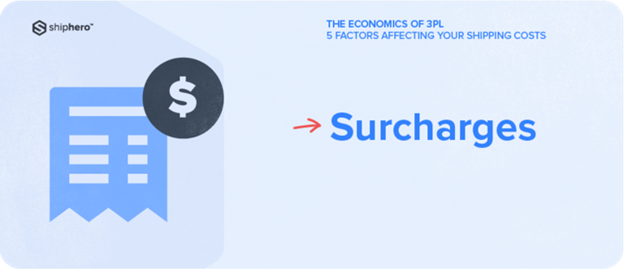
Factor 5 | Surcharges
Surcharges are a necessary evil in shipping and logistics, so they can be the bane of your bottom line if you’re not careful. That’s why it’s essential to be informed and proactive about the different types of surcharges your product lines may encounter.
Navigating outbound shipping can be a complex and costly process for 3PL operators. Negotiating base rates with carriers is just the beginning; understanding accessorial charges and selecting the best base rate based on package specifications is key to mitigating costs. The challenge lies in the surcharges associated with specialized services, which can drive up costs and make it challenging to predict expenditures.
Additionally, general rate increases can significantly impact carrier base rates for 3PLs. However, the right approach and tools can reduce shipping expenses. By utilizing shipping cost strategies, analyzing costs, and planning, surcharges can be minimized.
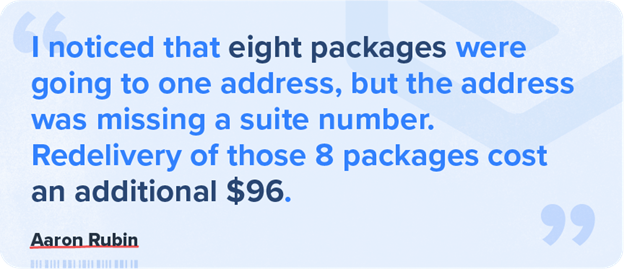
How to Reduce Shipping Charges
Size and Weight
It is important to be mindful of shipping charges, as they can quickly add up and cut into your profits. One way to reduce these costs is by considering the size and weight of your parcels. Oversized boxes or improper packaging can result in higher fees. Look for carriers that offer the correct type of flat-rate shipping or the fees that make the most sense for you and your products.
Additionally, be aware of dim weight pricing (as we discussed at the top of this article), which considers the box’s length, height, and weight. This can sometimes result in extra fees for light packages that take up a significant amount of truck space.
Team Training
Reducing shipping charges is crucial for businesses of all sizes, and optimizing warehouse operations can help achieve this goal. Proper software training is essential to maintain consistency with the packing team and reduce unnecessary costs.
A warehouse management system (WMS) like ShipHero can provide automation that streamlines business operations, but it needs to be used accurately. Your WMS training program should cover all aspects of the hardware and software and the different methods used to manage goods efficiently within the warehouse. By emphasizing the importance of WMS training and implementing consistent warehouse practices, your business can reduce shipping costs and improve overall efficiency.
Equipment
Troubleshooting internal errors such as incorrect scales and improperly stocked packing stations can also enable you to minimize touchpoints and increase automation. With automation rules, packers can always use the appropriate box when shipping specific products. These steps allow you to confidently assert control over your shipping process and save valuable business resources.
Automation
We offer a variety of automation rules to help businesses save money on shipping charges. Our VIP customer treatment rule ensures that your most valuable customers receive a gift SKU or marketing insert with their orders, express shipping, and prioritized order processing. Our pre-sale item rule helps businesses save by setting a partial shipping flag for orders that exceed a specific dollar amount.
Additionally, SKU-specific notes can be assigned to certain items, which is handy for fragile items that require special handling. Finally, we automate box type selections, streamlining the packing process and saving businesses time and money on shipping. With the proper automation rules, businesses can significantly reduce shipping charges and improve their bottom line.
3PL Profitability
To summarize, consider all five critical factors mentioned in this post to reduce your outbound shipping costs: destination and origin, delivery speed, warehouse team processes, special handling fees, and surcharges.
With the right tools and expertise, you can ensure that your 3PL profitability remains reliably on track. And with hard work and dedication to intelligent decisions about outbound shipping strategies—increasing or decreasing delivery speeds or minimizing surcharge risks— you should be more than capable of achieving your goals.
It takes a lot of work, but investing time now to craft an efficient system for managing outbound shipments will pay off down the line. To start managing your outbound shipments efficiently today, try a ShipHero demo and get a jump start on reducing those shipping costs!
Key Takeaways
- Five critical factors affecting shipping costs include weight and zone, delivery speed, warehouse team processes, special handling fees, and surcharges.
- Shipping fees increase as packages move further from their origin, and weight and package dimensions also significantly affect shipping costs.
- Duty relief programs for international shipping, such as Section 321, can save up to 20% on duty fees.
- Last-mile delivery challenges can be solved with partnerships like Veho, which can save money and streamline the process.
- Delivery speed is important for eCommerce businesses, but faster delivery times come with higher costs. Local fulfillment centers and efficient processes can help reduce costs.
- Investing in team training, efficient packing procedures, optimizing picking paths, using automation, and analyzing the correct data can improve warehouse efficiency and reduce costs.
- Hazmat and fragile handling fees can protect businesses from fines and reputation damage, but choosing the proper packaging and labeling is vital.
- Understanding surcharges and negotiating base rates can help mitigate shipping costs for 3PL operators. Planning and analyzing costs can also minimize surcharges.
About ShipHero: We make it simple for you to deliver your eCommerce. Our software helps you run your warehouse, and our outsourced shipping solutions eliminate the hassle of getting your products to your customers. With thousands of brands and 3PLs relying on us daily, we’re here to help with all your logistics needs.
Let us know how we can help you today by scheduling a call HERE.
